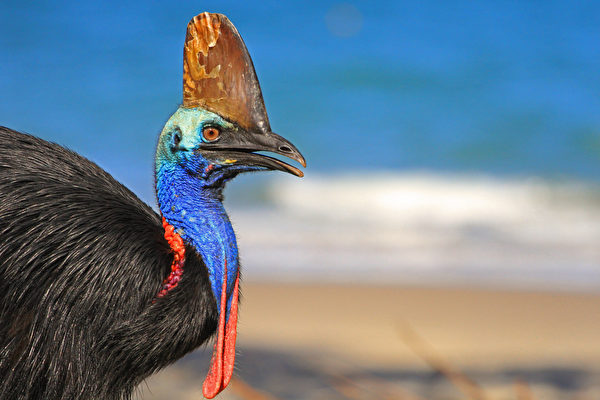The Southern Cassowary, known for its unique and beautiful appearance, has a deep cobalt-blue head and neck, topped with a brown “safety helmet” bony casque. They also sport two red wattles (fleshy folds of skin) hanging from their neck. Considered one of the most striking creatures in the Australian rainforest, they are also recognized as the “world’s most dangerous bird,” with their powerful legs and sharp dagger-like claws as their primary weapons.
However, this highly distinctive bird is now facing the threat of extinction, with its survival increasingly precarious.
The Southern Cassowary, resembling an ostrich in appearance, belongs to the group of flightless birds like their distant relatives, the Emus. Found in the rainforests of Australia, New Guinea, and some Pacific islands, they can reach heights of 1.5 meters and weigh up to 75 kilograms. These birds exhibit strong territorial behavior, emitting hissing and deep booming sounds when threatened.
“These birds are massive and could be likened to a modern-day dinosaur,” said Peter Rowles, chairman of a community group dedicated to protecting these endangered birds, to Agence France-Presse. “When you lock eyes with them for the first time, you might feel a hint of fear due to their large intimidating eyes.”
“The Cassowaries are awe-inspiring species, and encountering them in the wild is a fantastic experience,” remarked Darren Grover, Acting CEO of WWF Australia. “But caution is advised as they are naturally aggressive, large, and powerful creatures, and we need to allow them the space they require.”
The Australian government has classified the Southern Cassowary as an endangered species, considering them a “key species” in the local ecosystem, with an estimated wild population of around 4,500 individuals and a declining trend.
These birds play a critical role in the rainforests of northeastern Australia, being acclaimed as the “gardeners” of maintaining biodiversity. One of their essential functions is seed dispersal. The Cassowary consumes various fruits, including those with larger seeds that smaller birds cannot digest. They aid in spreading seeds through their excrement, contributing to maintaining plant diversity and forest structure.
If the Cassowaries were to disappear, many plant species relying on them for seed dispersal would struggle to reproduce. The decline in plant diversity would, in turn, affect other animals dependent on these plants for food and shelter. Over time, the entire rainforest ecosystem could face devastating disruptions.
Research indicates that the primary threats to Cassowaries include habitat loss, dog attacks, and vehicle collisions. In response, numerous animal conservation organizations, including the Rowles team, are making every effort to save these endangered birds. Their measures include setting up road signs to reduce speed, redesigning roads to protect their native habitat, and establishing Cassowary hospitals.
“We believe that in saving the Cassowaries, we are also preserving the health and prosperity of the rainforest habitats, allowing many other species to thrive,” stated Rowles.
Back in 2007, the Australian government initiated a nationwide recovery plan in collaboration with Indigenous communities and animal protection organizations, aiming to save this iconic species of the tropical rainforest and others. Last August, the government released a new report outlining efforts such as land buyback, improved road signage, and enhanced dog-owner education to further protect this endangered bird species. In April this year, the government announced a nature conservation plan, allocating more funds for protecting endangered species.
While the conservation efforts for Cassowaries still face many challenges, the urgency cannot be overstated. As emphasized by Rowles and Grover, saving the Cassowaries means safeguarding the intricate web of life in the Australian rainforests. The extinction of this crucial species would entail significant losses, influencing the future of the entire rainforest in northeastern Australia.

